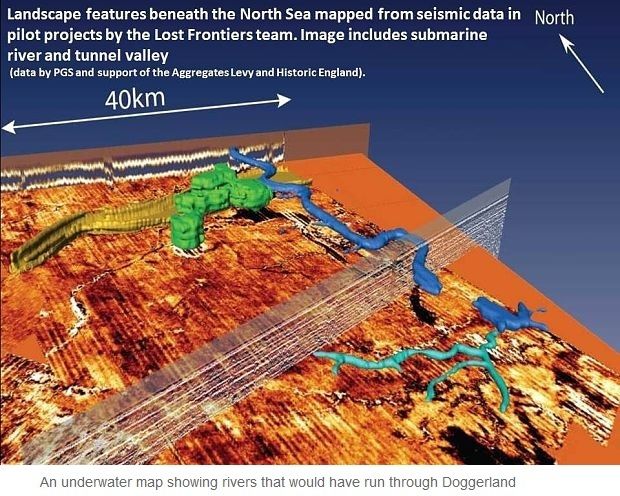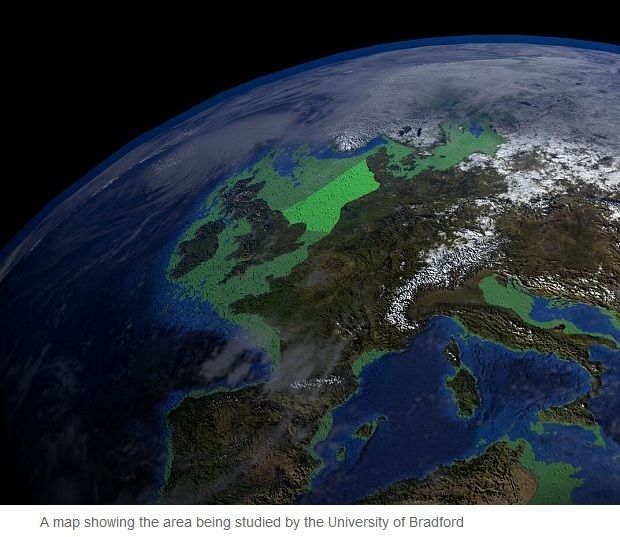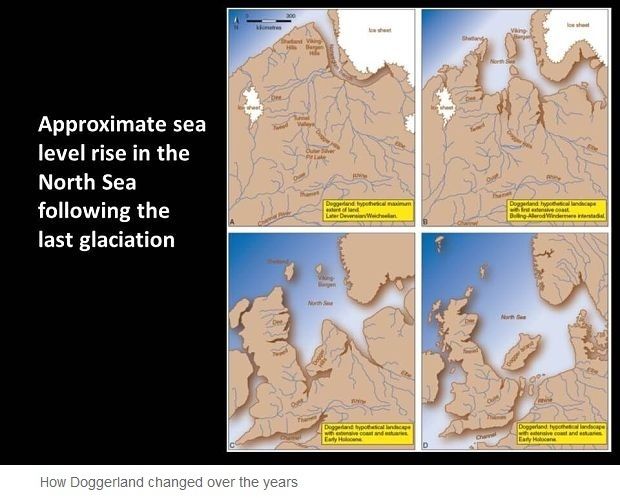Post by UKarchaeology on Sept 27, 2015 21:13:10 GMT
Archaeologists at the University of Bradford will be taking deep sea core samples to find the DNA of Doggerland to reconstruct the environment
A lost world off the British coast which was flooded by the rising North Sea thousands of years ago, is finally to reveal its secrets.
The ancient country of Doggerland was once the home to thousands of stone age settlers and was an important land bridge between Britain and Northern Europe.
Now archaeologists at the University of Bradford have begun a huge project to reconstruct the ancient Mesolithic landscape which is now hidden beneath the waves.
Using seabed mapping data gathered by energy companies, the team is planning to produce a detailed 3D chart that will show rivers, lakes, hills and coastlines of the country.
Specialist survey ships will also take core sediment samples from selected areas of the landscape to extract millions of fragments of DNA from plants and animals which once lived on the lost world.
“The only populated lands on earth that have not yet been explored in any depth are those which have been lost underneath the sea,” says Professor Vince Gaffney, Anniversary Chair in Landscape Archaeology at the University of Bradford.
““Although archaeologists have known for a long time that ancient climatic change and sea level rise must mean that Doggerland holds unique and important information about early human life in Europe, until now we have lacked the tools to investigate this area properly.”

Humans lived in Doggerland from around 10,000 BC until it was flooded at the end of the last ice age around 7,500 years ago. Recently a team at Imperial College showed that the later island of Doggerland was flooded in a single titanic event around 8000 years ago. A tsunami, with waves up to five metres in height, was triggered by a huge landslide off the coast of Norway. For hundreds of years, trawlermen fishing off the coast of Dogger Bank have pulled up finds and mammoth bones in their nets.
The team is hoping that the cool underwater conditions of the sunken land will have preserved DNA, so that they can build up a picture of how society and environment evolved during a period of catastrophic climate change.
“This project is exciting not only because of what it will reveal about Doggerland, but because it gives us a whole new way of approaching the massive areas of land that were populated by humans but which now lie beneath the sea,” added Professor Gaffney.
“This project will develop technologies and methodologies that archaeologists around the world can use to explore similar landscapes including those around the Americas and in South East Asia,”

Dr David Smith, University of Birmingham added: “ “This is the first time that this type of reconstruction has been attempted at this detail and scale in any marine environment.
“The opportunity to provide complementary analysis of established and new technologies, including DNA, at such a scale is also likely to provide a step change in our understanding of past environments and our approach to landscape reconstruction.”
Robin Allaby fro, the School of Life Sciences at the University of Warwick said: "The constant environment of the sea floor preserves ancient DNA exceptionally well allowing us to reconstruct palaeoenvironments many thousands of years older than is possible on land at the same latitude,” said Professor Robin Allaby, School of Life Sciences, University of Warwick
"The project promises unprecedented insight into the Mesolithic in North West Europe and will also enable us to continue to push the frontiers of sedaDNA analysis.”

(pics & source: www.telegraph.co.uk/news/earth/environment/archaeology/11836627/British-Atlantis-archaeologists-begin-exploring-lost-world-of-Doggerland.html )
A lost world off the British coast which was flooded by the rising North Sea thousands of years ago, is finally to reveal its secrets.
The ancient country of Doggerland was once the home to thousands of stone age settlers and was an important land bridge between Britain and Northern Europe.
Now archaeologists at the University of Bradford have begun a huge project to reconstruct the ancient Mesolithic landscape which is now hidden beneath the waves.
Using seabed mapping data gathered by energy companies, the team is planning to produce a detailed 3D chart that will show rivers, lakes, hills and coastlines of the country.
Specialist survey ships will also take core sediment samples from selected areas of the landscape to extract millions of fragments of DNA from plants and animals which once lived on the lost world.
“The only populated lands on earth that have not yet been explored in any depth are those which have been lost underneath the sea,” says Professor Vince Gaffney, Anniversary Chair in Landscape Archaeology at the University of Bradford.
““Although archaeologists have known for a long time that ancient climatic change and sea level rise must mean that Doggerland holds unique and important information about early human life in Europe, until now we have lacked the tools to investigate this area properly.”

Humans lived in Doggerland from around 10,000 BC until it was flooded at the end of the last ice age around 7,500 years ago. Recently a team at Imperial College showed that the later island of Doggerland was flooded in a single titanic event around 8000 years ago. A tsunami, with waves up to five metres in height, was triggered by a huge landslide off the coast of Norway. For hundreds of years, trawlermen fishing off the coast of Dogger Bank have pulled up finds and mammoth bones in their nets.
The team is hoping that the cool underwater conditions of the sunken land will have preserved DNA, so that they can build up a picture of how society and environment evolved during a period of catastrophic climate change.
“This project is exciting not only because of what it will reveal about Doggerland, but because it gives us a whole new way of approaching the massive areas of land that were populated by humans but which now lie beneath the sea,” added Professor Gaffney.
“This project will develop technologies and methodologies that archaeologists around the world can use to explore similar landscapes including those around the Americas and in South East Asia,”

Dr David Smith, University of Birmingham added: “ “This is the first time that this type of reconstruction has been attempted at this detail and scale in any marine environment.
“The opportunity to provide complementary analysis of established and new technologies, including DNA, at such a scale is also likely to provide a step change in our understanding of past environments and our approach to landscape reconstruction.”
Robin Allaby fro, the School of Life Sciences at the University of Warwick said: "The constant environment of the sea floor preserves ancient DNA exceptionally well allowing us to reconstruct palaeoenvironments many thousands of years older than is possible on land at the same latitude,” said Professor Robin Allaby, School of Life Sciences, University of Warwick
"The project promises unprecedented insight into the Mesolithic in North West Europe and will also enable us to continue to push the frontiers of sedaDNA analysis.”

(pics & source: www.telegraph.co.uk/news/earth/environment/archaeology/11836627/British-Atlantis-archaeologists-begin-exploring-lost-world-of-Doggerland.html )
